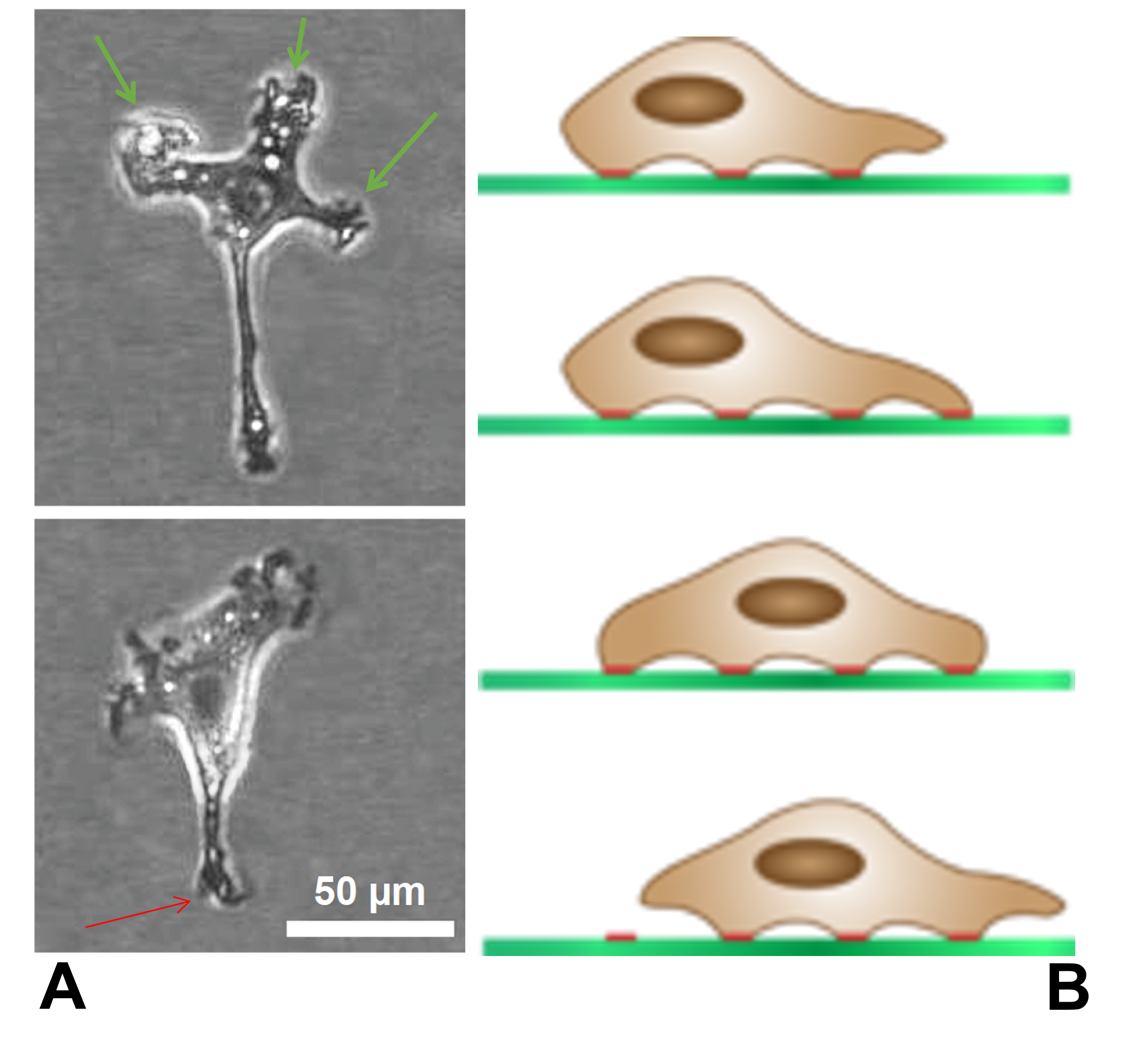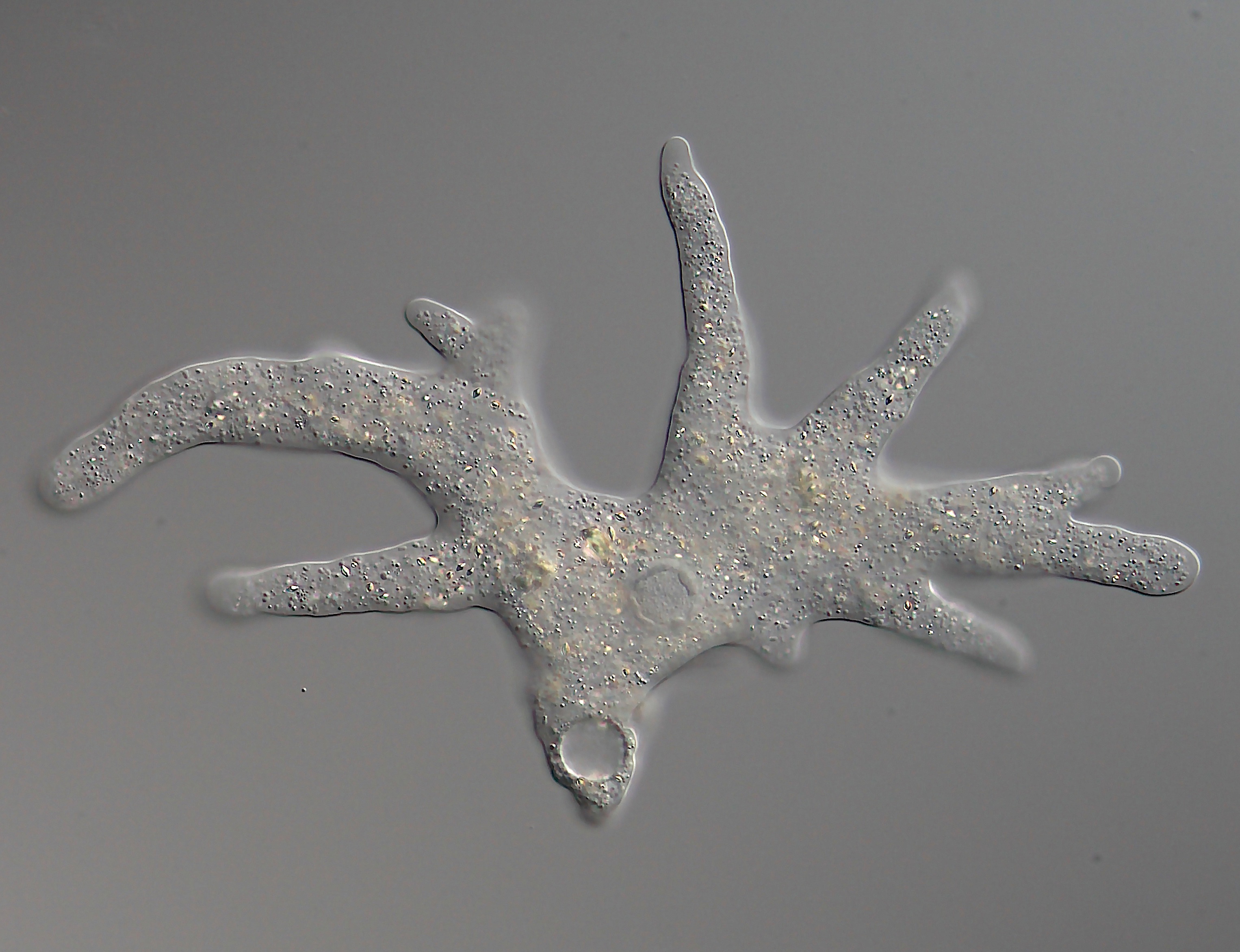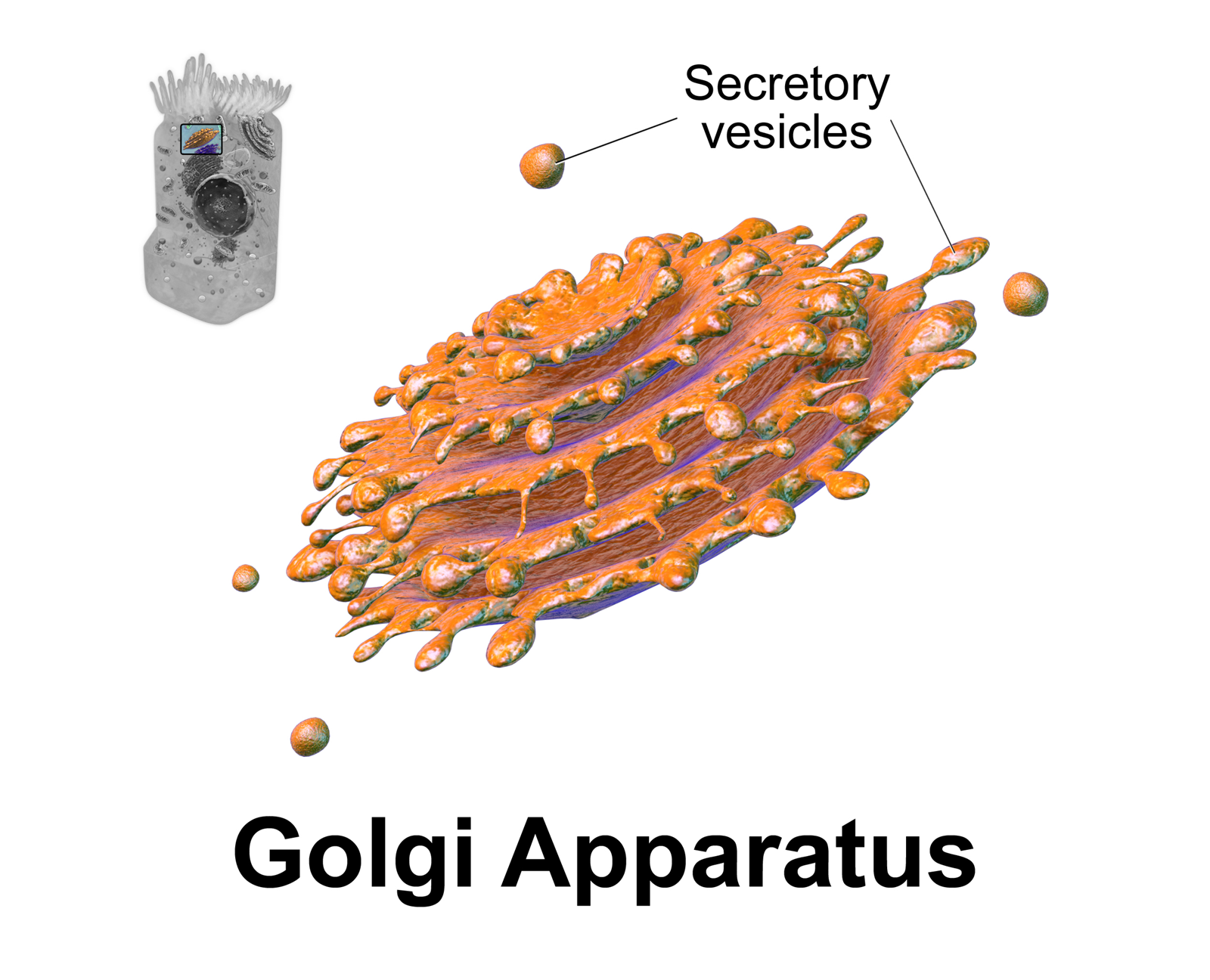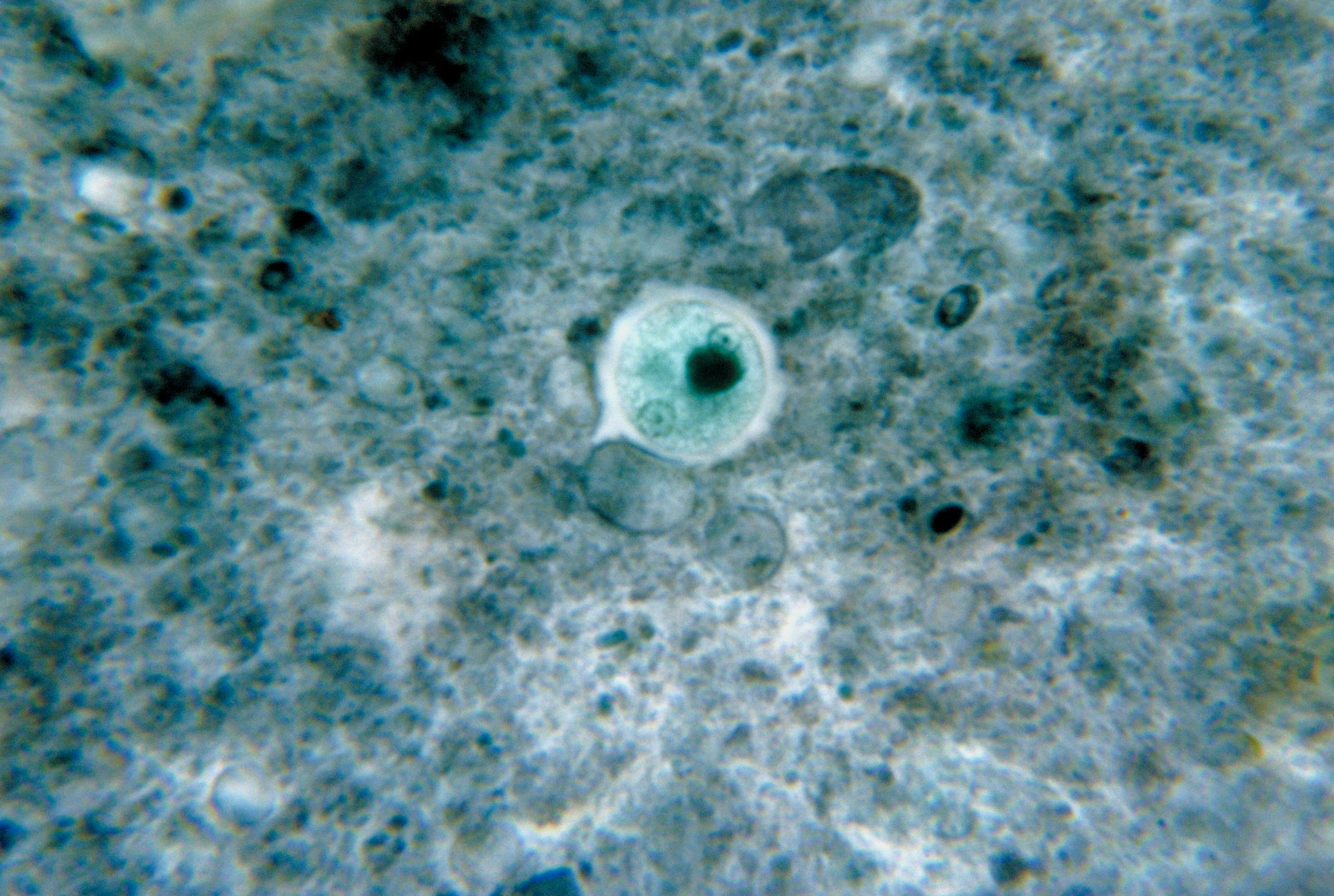|
Luapeleamoeba Hula
''Luapeleamoeba'' is a genus of naked amoebae of the family Acanthamoebidae. Morphology ''Luapeleamoeba'' are uninucleate amoebae that, during locomotion, generate a single broad, hyaline lamellipodium with inferior triangular pseudopodia at the edge directing the movement. Behind the lamellipodium there's a thick region of cytoplasm with granules containing a contractile vacuole usually posterior to the single nucleus. There is a big nucleolus with a diameter at least half of the nucleus' diameter. There is a centrosomal region near the nucleus with a Golgi apparatus, other vesicles, and an electron-dense lamellate microtubule-organizing center, which is visibly smaller and less lamellate than those seen in other acanthamoeboid genera. The amoeba is thickest near the contractile vacuole and the nucleus, and tapers gradually toward the edges, giving the overall appearance of a small shield volcano. The floating form is round, although not smooth. No flagella have been seen. The ... [...More Info...] [...Related Items...] OR: [Wikipedia] [Google] [Baidu] |
Acanthamoebidae
Acanthamoebidae is a family of single-celled eukaryotes within the group Amoebozoa. It gets its name from '' Acanthamoeba'', its best-known member. However, it also includes other species, such as '' Comandonia operculata'' and '' Protacanthamoeba bohemica''. Many kinds of Acanthamoebidae are highly prevalent in the soil and water of a variety of environments. They are similar to Hartmannella, but have differently structured pseudopodia, in regard to the actin microfilaments that comprise them. Its most prominent member, ''Acanthamoeba'', can be potentially pathogenic to humans and animals. It has been described as having a common origin with the Entamoebidae and Dictyosteliida. Structure Members of Acanthamoebidae have a specific form of pseudopodia, dubbed acanthopodia. These acanthopodia are continuously formed and reabsorbed, protrude from every area of the cell's surface, and are usually, short and fine. An exception would be ''A. astronyxis'' and ''A. comandoni'', in ... [...More Info...] [...Related Items...] OR: [Wikipedia] [Google] [Baidu] |
Nucleus (cell)
The cell nucleus (; : nuclei) is a membrane-bound organelle found in eukaryotic cells. Eukaryotic cells usually have a single nucleus, but a few cell types, such as mammalian red blood cells, have no nuclei, and a few others including osteoclasts have many. The main structures making up the nucleus are the nuclear envelope, a double membrane that encloses the entire organelle and isolates its contents from the cellular cytoplasm; and the nuclear matrix, a network within the nucleus that adds mechanical support. The cell nucleus contains nearly all of the cell's genome. Nuclear DNA is often organized into multiple chromosomes – long strands of DNA dotted with various proteins, such as histones, that protect and organize the DNA. The genes within these chromosomes are structured in such a way to promote cell function. The nucleus maintains the integrity of genes and controls the activities of the cell by regulating gene expression. Because the nuclear envelope is imperm ... [...More Info...] [...Related Items...] OR: [Wikipedia] [Google] [Baidu] |
Lamellipodium
The lamellipodium (: lamellipodia) (from Latin ''lamella'', related to ', "thin sheet", and the Greek radical ''pod-'', "foot") is a cytoskeletal protein actin projection on the leading edge of the cell. It contains a quasi-two-dimensional actin mesh; the whole structure propels the cell across a substrate. Within the lamellipodia are ribs of actin called microspikes, which, when they spread beyond the lamellipodium frontier, are called filopodia. The lamellipodium is born of actin nucleation in the plasma membrane of the cell and is the primary area of actin incorporation or microfilament formation of the cell. Description Lamellipodia are found primarily in all mobile cells, such as the keratinocytes of fish and frogs, which are involved in the quick repair of wounds. The lamellipodia of these keratinocytes allow them to move at speeds of 10–20 μm / min over epithelial surfaces. When separated from the main part of a cell, a lamellipodium can still crawl a ... [...More Info...] [...Related Items...] OR: [Wikipedia] [Google] [Baidu] |
Pseudopodia
A pseudopod or pseudopodium (: pseudopods or pseudopodia) is a temporary arm-like projection of a eukaryotic cell membrane that is emerged in the direction of movement. Filled with cytoplasm, pseudopodia primarily consist of actin filaments and may also contain microtubules and intermediate filaments. Pseudopods are used for motility and ingestion. They are often found in amoebas. Different types of pseudopodia can be classified by their distinct appearances. Lamellipodia are broad and thin. Filopodia are slender, thread-like, and are supported largely by microfilaments. Lobopodia are bulbous and amoebic. Reticulopodia are complex structures bearing individual pseudopodia which form irregular nets. Axopodia are the phagocytosis type with long, thin pseudopods supported by complex microtubule arrays enveloped with cytoplasm; they respond rapidly to physical contact. Generally, several pseudopodia arise from the surface of the body, (''polypodial'', for example, '' Amoeba ... [...More Info...] [...Related Items...] OR: [Wikipedia] [Google] [Baidu] |
Vacuole
A vacuole () is a membrane-bound organelle which is present in Plant cell, plant and Fungus, fungal Cell (biology), cells and some protist, animal, and bacterial cells. Vacuoles are essentially enclosed compartments which are filled with water containing inorganic and organic molecules including enzymes in Solutes, solution, though in certain cases they may contain solids which have been engulfed. Vacuoles are formed by the fusion of multiple membrane Vesicle (biology), vesicles and are effectively just larger forms of these. The organelle has no basic shape or size; its structure varies according to the requirements of the cell. Discovery Antonie van Leeuwenhoek described the plant vacuole in 1676. Contractile vacuoles ("stars") were first observed by Spallanzani (1776) in protozoa, although mistaken for respiratory organs. Félix Dujardin, Dujardin (1841) named these "stars" as ''vacuoles''. In 1842, Matthias Jakob Schleiden, Schleiden applied the term for plant cells, to dist ... [...More Info...] [...Related Items...] OR: [Wikipedia] [Google] [Baidu] |
Nucleolus
The nucleolus (; : nucleoli ) is the largest structure in the cell nucleus, nucleus of eukaryote, eukaryotic cell (biology), cells. It is best known as the site of ribosome biogenesis. The nucleolus also participates in the formation of signal recognition particles and plays a role in the cell's response to stress. Nucleoli are made of proteins, DNA and RNA, and form around specific chromosomal regions called nucleolar organizing regions. Malfunction of the nucleolus is the cause of several human conditions called "nucleolopathies" and the nucleolus is being investigated as a target for cancer chemotherapy. History The nucleolus was identified by bright-field microscopy during the 1830s. Theodor Schwann in his 1839 treatise described that Matthias Jakob Schleiden, Schleiden had identified small corpuscles in nuclei, and named the structures "Kernkörperchen". In a 1947 translation of the work to English, the structure was named "nucleolus". Little was known about the fun ... [...More Info...] [...Related Items...] OR: [Wikipedia] [Google] [Baidu] |
Golgi Apparatus
The Golgi apparatus (), also known as the Golgi complex, Golgi body, or simply the Golgi, is an organelle found in most eukaryotic Cell (biology), cells. Part of the endomembrane system in the cytoplasm, it protein targeting, packages proteins into membrane-bound Vesicle (biology and chemistry), vesicles inside the cell before the vesicles are sent to their destination. It resides at the intersection of the secretory, lysosomal, and Endocytosis, endocytic pathways. It is of particular importance in processing proteins for secretion, containing a set of glycosylation enzymes that attach various sugar monomers to proteins as the proteins move through the apparatus. The Golgi apparatus was identified in 1898 by the Italian biologist and pathologist Camillo Golgi. The organelle was later named after him in the 1910s. Discovery Because of its large size and distinctive structure, the Golgi apparatus was one of the first organelles to be discovered and observed in detail. It was d ... [...More Info...] [...Related Items...] OR: [Wikipedia] [Google] [Baidu] |
Microtubule-organizing Center
The microtubule-organizing center (MTOC) is a structure found in eukaryotic cells from which microtubules emerge. MTOCs have two main functions: the organization of eukaryotic flagella and cilia and the organization of the mitotic and meiotic spindle apparatus, which separate the chromosomes during cell division. The MTOC is a major site of microtubule nucleation and can be visualized in cells by immunohistochemical detection of γ-tubulin. The morphological characteristics of MTOCs vary between the different phyla and kingdoms. In animals, the two most important types of MTOCs are 1) the basal bodies associated with cilia and flagella and 2) the centrosome associated with spindle formation. Organization Microtubule-organizing centers function as the site where microtubule formation begins, as well as a location where free-ends of microtubules attract to. Within the cells, microtubule-organizing centers can take on many different forms. An array of microtubules can arrange themsel ... [...More Info...] [...Related Items...] OR: [Wikipedia] [Google] [Baidu] |
Shield Volcano
A shield volcano is a type of volcano named for its low profile, resembling a shield lying on the ground. It is formed by the eruption of highly fluid (low viscosity) lava, which travels farther and forms thinner flows than the more viscous lava erupted from a stratovolcano. Repeated eruptions result in the steady accumulation of broad sheets of lava, building up the shield volcano's distinctive form. Shield volcanoes are found wherever fluid, low-silica lava reaches the surface of a rocky planet. However, they are most characteristic of ocean Volcanic island, island volcanism associated with Hotspot (geology), hot spots or with Rift, continental rift volcanism. They include the largest active volcanoes on Earth, such as Mauna Loa. Giant shield volcanoes are found on other planets of the Solar System, including Olympus Mons on Mars and Sapas Mons on Venus. Etymology The term 'shield volcano' is taken from the German term ''Schildvulkan'', coined by the Austrian geologist Eduar ... [...More Info...] [...Related Items...] OR: [Wikipedia] [Google] [Baidu] |
Microbial Cyst
A microbial cyst is a resting or dormant stage of a microorganism, that can be thought of as a state of suspended animation in which the metabolic processes of the cell are slowed and the cell ceases all activities like feeding and locomotion. Many groups of single-celled, microscopic organisms, or microbes, possess the ability to enter this dormant state. Encystment, the process of cyst formation, can function as a method for dispersal and as a way for an organism to survive in unfavorable environmental conditions. These two functions can be combined when a microbe needs to be able to survive harsh conditions between habitable environments (such as between hosts) in order to disperse. Cysts can also be sites for nuclear reorganization and cell division, and in parasitic species they are often the infectious stage between hosts. When the encysted microbe reaches an environment favorable to its growth and survival, the cyst wall breaks down by a process known as excystation. E ... [...More Info...] [...Related Items...] OR: [Wikipedia] [Google] [Baidu] |






